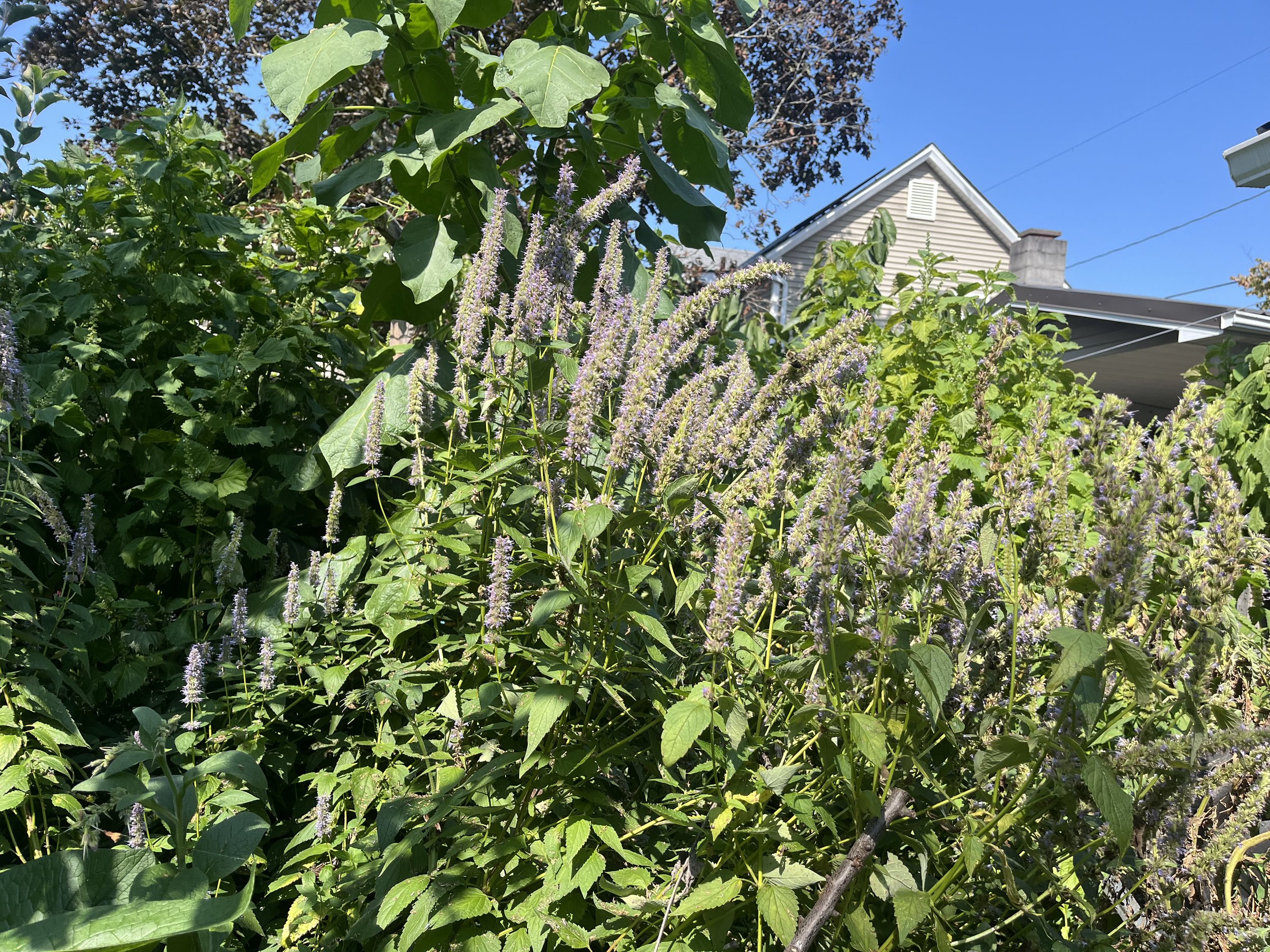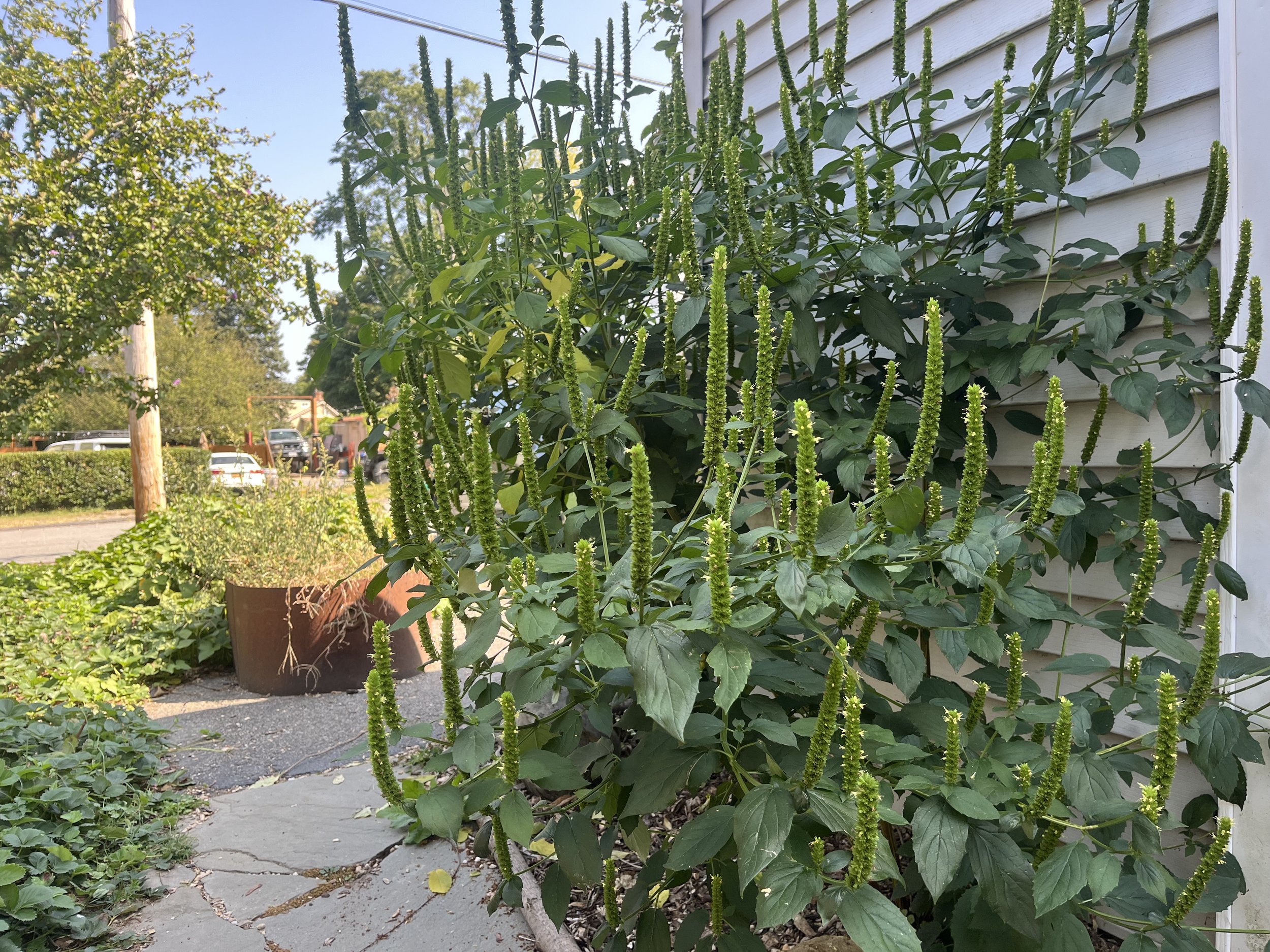The third piece of the project is entitled “Agastache”. Agastache is a genus of plants in the Lamiaceae family - the mint family. We have three Agastache species growing in our yard. Agastache foeniculum / Anise Hyssop is probably the one most commonly planted around here. The leaves have a strong licorice scent. We also have Agastache scrophularifolia / Purple Giant Hyssop, and newly planted this year is Agastache nepetoides / Yellow Giant Hyssop. Scrophularifolia is a bit unruly and large. I had to move it a couple years ago to a spot where it could dominate a little more. It seeds itself all over, but I always say that I’d rather have to pull plants to keep them from taking over, rather than have to coddle them to grow. Nepetoides hasn’t the showiest flowers; they’re mostly green spires with just a handful of tiny yellow flowers on each. But the bumble bees are constantly feeding on it, and the form of the plant it very neat. I planted it because I heard the juiced plant is a poison ivy rash remedy. Jewelweed is commonly used for poison ivy rashes, but it needs more processing than A. nepetoides. Hopefully I’ll never need to use those plants for that purpose anyway.
I love our plants in the Agastache genus because they bloom for a long time, they’re fragrant, and most importantly they are buzzing like mad with all kinds of bees when they’re in bloom. It’s really fun to sit and watch, which is actually what I did to come up with this tune. I had had an idea for a melody, and had been thinking of our Agastaches lately. So on Monday I worked at little at the piano. But I wasn’t happy with what I was coming up with, so I took a break and went out and sat in a spot in the garden that was near the foeniculum and scrophularifolia. I took in and admired their scents, their looks, and the abundant nectar indicated by the impressive buzz of insects around them. Then I opened myself to any musical ideas that wanted to come forth. Pretty quickly the rhythmic pattern of this song came to me, along with some rough ideas of a melody. I sang it into my voice memos application on my telephone. Then I went back to the piano and starting improvising around the idea. I made another voice memo at the piano. The idea had been caught! This experience was very energizing, just as catching the ideas of the first two Plant Songs was. The next day I went to the piano to figure out the song, and I used the voice memo of the improv at the piano to get going. I had never used the voice memos application for composing like that, nor had I ever sat with a plant to get a musical idea. Here’s to new ways of working!
There are some interesting things happening in the process that I’ve been thinking about which have to do with time. That moment when the original idea is caught is usually the height of my emotional connection to the song - before it’s all flushed out. Then the goal becomes to get it all finished before that emotional connection wanes too much. Finishing the song involves figuring out all the musical parts - solidifying the melody, rhythm, chords, form, etc., then learning to play the piece, and then getting a decent recording of it. Sometimes figuring out some musical elements actually contributes positively to my emotional connection, such as when I found the countermelodies that my right hand plays under the melody at the end of the A and B sections of “Agastache”. But most often the process grates away at the emotional connection, which means that it’s best done as quickly and efficiently as possible (especially when tomatoes need harvesting to boot!). Nothing degrades the emotional connection more than recording multiple takes, so it’s also best to be most efficient in practicing only the spots that need it, and to not do too much improvisation practice before hitting record. It’s a delicate balance of knowing my way around the form without it getting stale. I can usually revive my emotional connection by taking some time away; sometimes that’s 15 minutes, sometimes a couple hours, or sometimes a day. It’s also easier to maintain an emotional connection with my own compositions since they’re a personal expression of something I feel. But getting from the moment of catching the idea, to the moment of a finished recording is usually best done quickly, at least in my experience. There are a couple of older songs of mine that have special moments for me in them - moments that really excited me when they revealed themselves; and I’ve since lost the feeling of those moments. But I trust that listeners might hear those moments now and experience what I felt when they were fresh to me.
I hope you enjoy “Agastache”. I look forward to playing this with a band someday. I could have used an Eastman drummer for this recording - like a Dave Tedeschi, or a Jared Schonig, or a Ted Poor. I was hearing them as I played it.
Agastache foeniculum / Anise Hyssop. Flowers are a little past their prime now, but still buzzing with bees.
Agastache nepetoides / Yellow Giant Hyssop
Agastache scrophularifolia / Purple Giant Hyssop


